Strategic Human Resource Management: Policies, Strategies, and Impacts
VerifiedAdded on 2020/06/06
|11
|3243
|406
Report
AI Summary
This report provides a comprehensive overview of Strategic Human Resource Management (SHRM). It explores the core concepts of SHRM, including strategic planning, performance management, employee relations, and industrial relations. The report details how SHRM aligns internal strengths and weaknesses with external opportunities and threats, emphasizing the importance of government policies, occupational safety, and employee welfare. It discusses strategic management at different levels (business, functional, and corporate) and highlights the significance of human resource planning in education. Furthermore, the report examines performance management cycles, training and development, employee relations, and diversity management within the workplace, emphasizing the need for a positive and inclusive work environment. The report concludes by stressing the importance of effective resource utilization and the development of strong relationships between managers and employees to achieve organizational success.
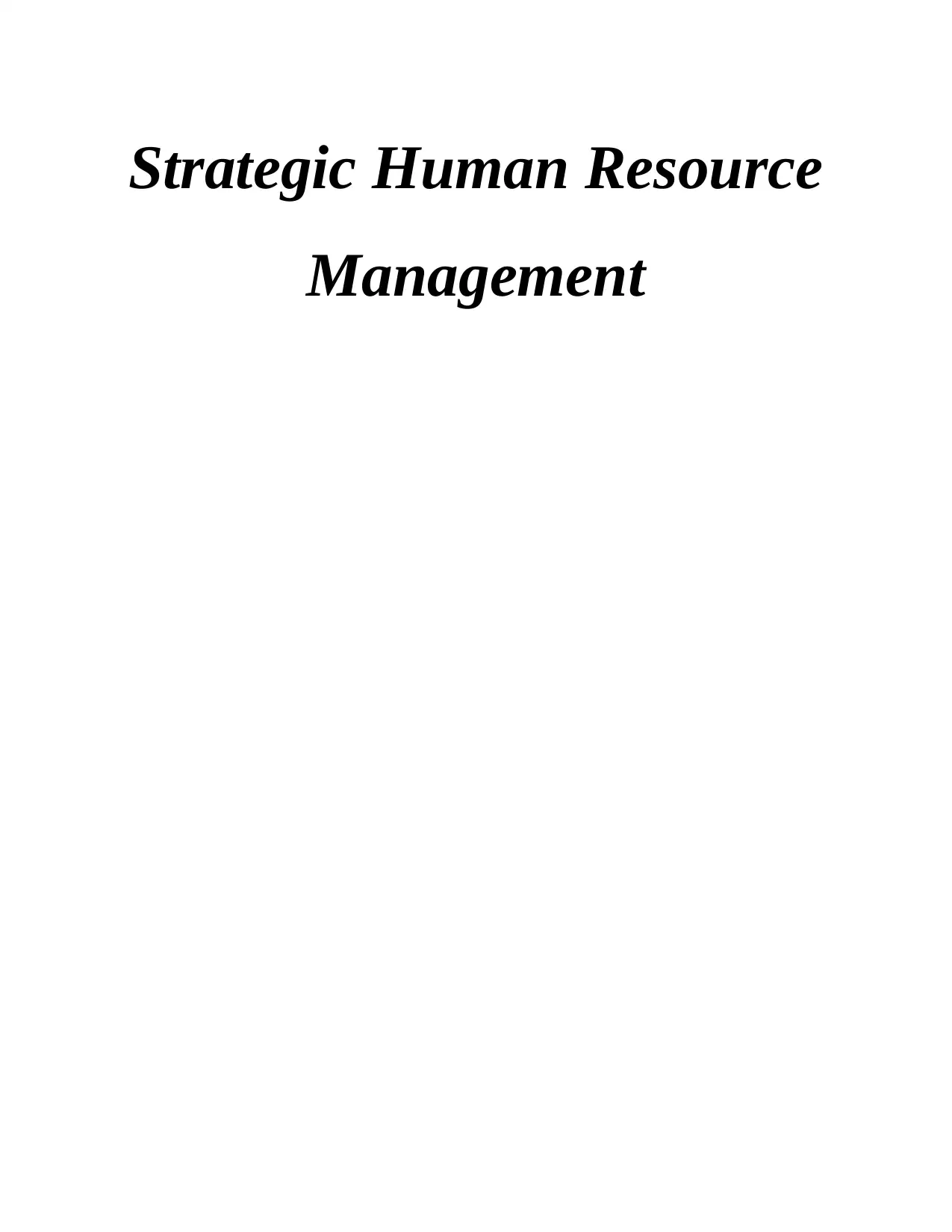
Strategic Human Resource
Management
Management
Paraphrase This Document
Need a fresh take? Get an instant paraphrase of this document with our AI Paraphraser
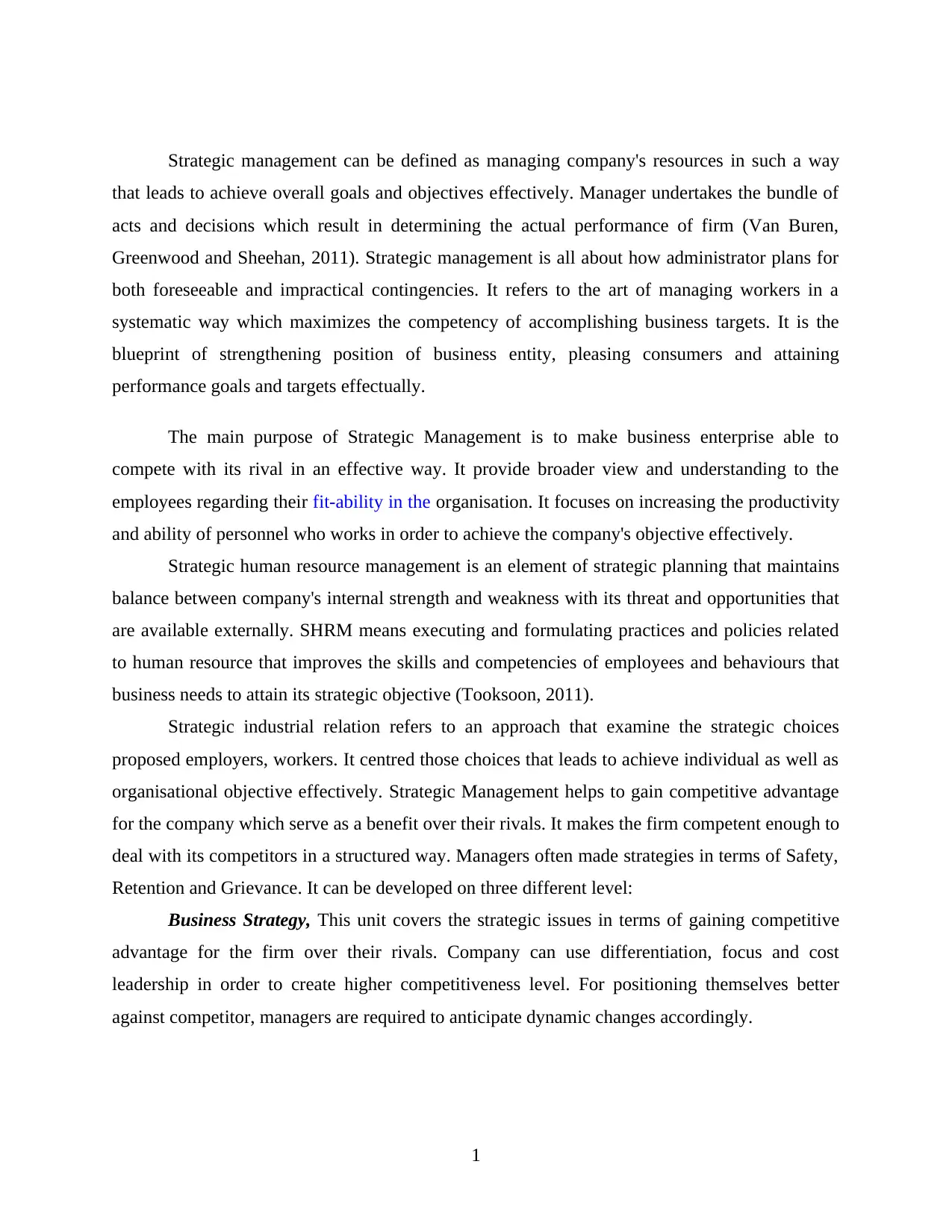
Strategic management can be defined as managing company's resources in such a way
that leads to achieve overall goals and objectives effectively. Manager undertakes the bundle of
acts and decisions which result in determining the actual performance of firm (Van Buren,
Greenwood and Sheehan, 2011). Strategic management is all about how administrator plans for
both foreseeable and impractical contingencies. It refers to the art of managing workers in a
systematic way which maximizes the competency of accomplishing business targets. It is the
blueprint of strengthening position of business entity, pleasing consumers and attaining
performance goals and targets effectually.
The main purpose of Strategic Management is to make business enterprise able to
compete with its rival in an effective way. It provide broader view and understanding to the
employees regarding their fit-ability in the organisation. It focuses on increasing the productivity
and ability of personnel who works in order to achieve the company's objective effectively.
Strategic human resource management is an element of strategic planning that maintains
balance between company's internal strength and weakness with its threat and opportunities that
are available externally. SHRM means executing and formulating practices and policies related
to human resource that improves the skills and competencies of employees and behaviours that
business needs to attain its strategic objective (Tooksoon, 2011).
Strategic industrial relation refers to an approach that examine the strategic choices
proposed employers, workers. It centred those choices that leads to achieve individual as well as
organisational objective effectively. Strategic Management helps to gain competitive advantage
for the company which serve as a benefit over their rivals. It makes the firm competent enough to
deal with its competitors in a structured way. Managers often made strategies in terms of Safety,
Retention and Grievance. It can be developed on three different level:
Business Strategy, This unit covers the strategic issues in terms of gaining competitive
advantage for the firm over their rivals. Company can use differentiation, focus and cost
leadership in order to create higher competitiveness level. For positioning themselves better
against competitor, managers are required to anticipate dynamic changes accordingly.
1
that leads to achieve overall goals and objectives effectively. Manager undertakes the bundle of
acts and decisions which result in determining the actual performance of firm (Van Buren,
Greenwood and Sheehan, 2011). Strategic management is all about how administrator plans for
both foreseeable and impractical contingencies. It refers to the art of managing workers in a
systematic way which maximizes the competency of accomplishing business targets. It is the
blueprint of strengthening position of business entity, pleasing consumers and attaining
performance goals and targets effectually.
The main purpose of Strategic Management is to make business enterprise able to
compete with its rival in an effective way. It provide broader view and understanding to the
employees regarding their fit-ability in the organisation. It focuses on increasing the productivity
and ability of personnel who works in order to achieve the company's objective effectively.
Strategic human resource management is an element of strategic planning that maintains
balance between company's internal strength and weakness with its threat and opportunities that
are available externally. SHRM means executing and formulating practices and policies related
to human resource that improves the skills and competencies of employees and behaviours that
business needs to attain its strategic objective (Tooksoon, 2011).
Strategic industrial relation refers to an approach that examine the strategic choices
proposed employers, workers. It centred those choices that leads to achieve individual as well as
organisational objective effectively. Strategic Management helps to gain competitive advantage
for the company which serve as a benefit over their rivals. It makes the firm competent enough to
deal with its competitors in a structured way. Managers often made strategies in terms of Safety,
Retention and Grievance. It can be developed on three different level:
Business Strategy, This unit covers the strategic issues in terms of gaining competitive
advantage for the firm over their rivals. Company can use differentiation, focus and cost
leadership in order to create higher competitiveness level. For positioning themselves better
against competitor, managers are required to anticipate dynamic changes accordingly.
1
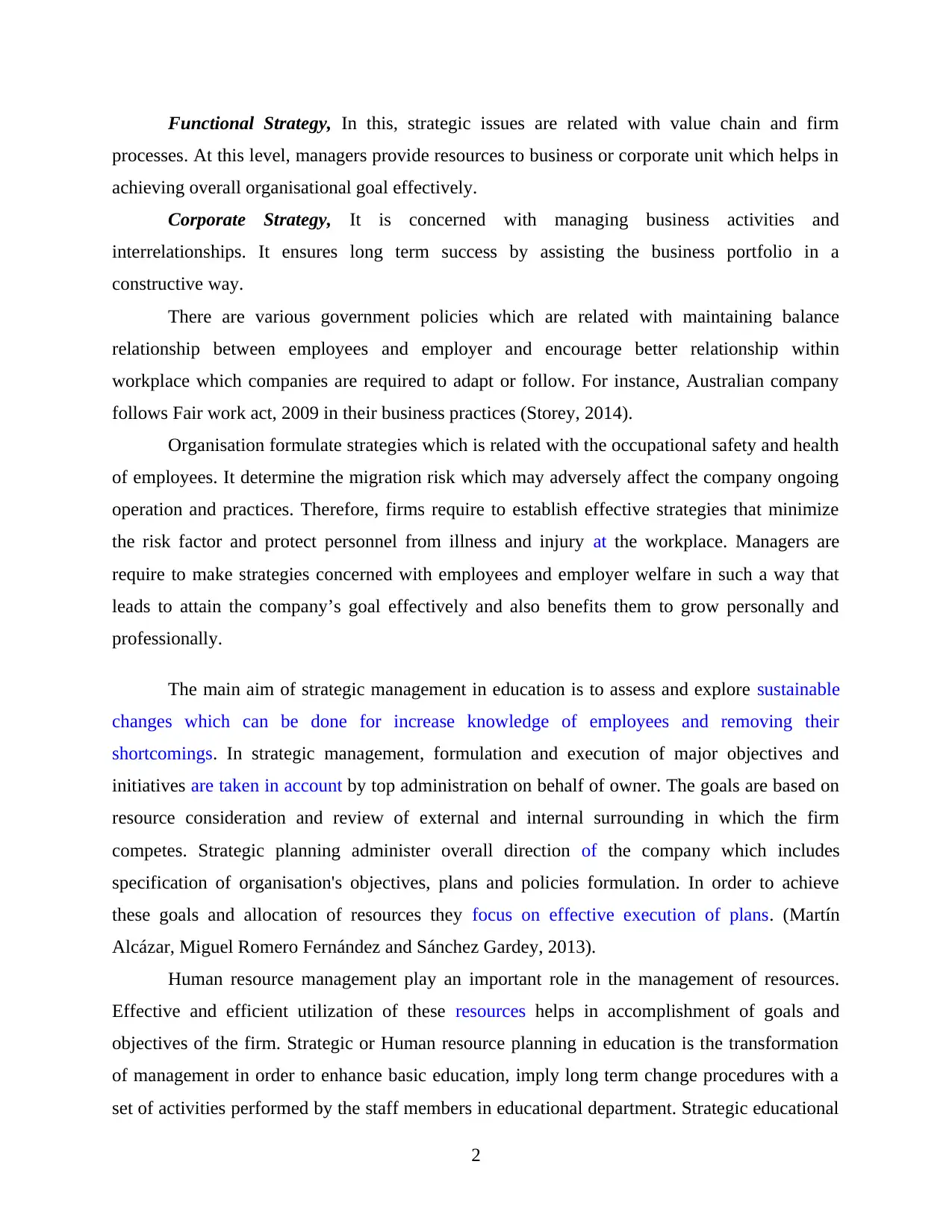
Functional Strategy, In this, strategic issues are related with value chain and firm
processes. At this level, managers provide resources to business or corporate unit which helps in
achieving overall organisational goal effectively.
Corporate Strategy, It is concerned with managing business activities and
interrelationships. It ensures long term success by assisting the business portfolio in a
constructive way.
There are various government policies which are related with maintaining balance
relationship between employees and employer and encourage better relationship within
workplace which companies are required to adapt or follow. For instance, Australian company
follows Fair work act, 2009 in their business practices (Storey, 2014).
Organisation formulate strategies which is related with the occupational safety and health
of employees. It determine the migration risk which may adversely affect the company ongoing
operation and practices. Therefore, firms require to establish effective strategies that minimize
the risk factor and protect personnel from illness and injury at the workplace. Managers are
require to make strategies concerned with employees and employer welfare in such a way that
leads to attain the company’s goal effectively and also benefits them to grow personally and
professionally.
The main aim of strategic management in education is to assess and explore sustainable
changes which can be done for increase knowledge of employees and removing their
shortcomings. In strategic management, formulation and execution of major objectives and
initiatives are taken in account by top administration on behalf of owner. The goals are based on
resource consideration and review of external and internal surrounding in which the firm
competes. Strategic planning administer overall direction of the company which includes
specification of organisation's objectives, plans and policies formulation. In order to achieve
these goals and allocation of resources they focus on effective execution of plans. (Martín
Alcázar, Miguel Romero Fernández and Sánchez Gardey, 2013).
Human resource management play an important role in the management of resources.
Effective and efficient utilization of these resources helps in accomplishment of goals and
objectives of the firm. Strategic or Human resource planning in education is the transformation
of management in order to enhance basic education, imply long term change procedures with a
set of activities performed by the staff members in educational department. Strategic educational
2
processes. At this level, managers provide resources to business or corporate unit which helps in
achieving overall organisational goal effectively.
Corporate Strategy, It is concerned with managing business activities and
interrelationships. It ensures long term success by assisting the business portfolio in a
constructive way.
There are various government policies which are related with maintaining balance
relationship between employees and employer and encourage better relationship within
workplace which companies are required to adapt or follow. For instance, Australian company
follows Fair work act, 2009 in their business practices (Storey, 2014).
Organisation formulate strategies which is related with the occupational safety and health
of employees. It determine the migration risk which may adversely affect the company ongoing
operation and practices. Therefore, firms require to establish effective strategies that minimize
the risk factor and protect personnel from illness and injury at the workplace. Managers are
require to make strategies concerned with employees and employer welfare in such a way that
leads to attain the company’s goal effectively and also benefits them to grow personally and
professionally.
The main aim of strategic management in education is to assess and explore sustainable
changes which can be done for increase knowledge of employees and removing their
shortcomings. In strategic management, formulation and execution of major objectives and
initiatives are taken in account by top administration on behalf of owner. The goals are based on
resource consideration and review of external and internal surrounding in which the firm
competes. Strategic planning administer overall direction of the company which includes
specification of organisation's objectives, plans and policies formulation. In order to achieve
these goals and allocation of resources they focus on effective execution of plans. (Martín
Alcázar, Miguel Romero Fernández and Sánchez Gardey, 2013).
Human resource management play an important role in the management of resources.
Effective and efficient utilization of these resources helps in accomplishment of goals and
objectives of the firm. Strategic or Human resource planning in education is the transformation
of management in order to enhance basic education, imply long term change procedures with a
set of activities performed by the staff members in educational department. Strategic educational
2
⊘ This is a preview!⊘
Do you want full access?
Subscribe today to unlock all pages.

Trusted by 1+ million students worldwide
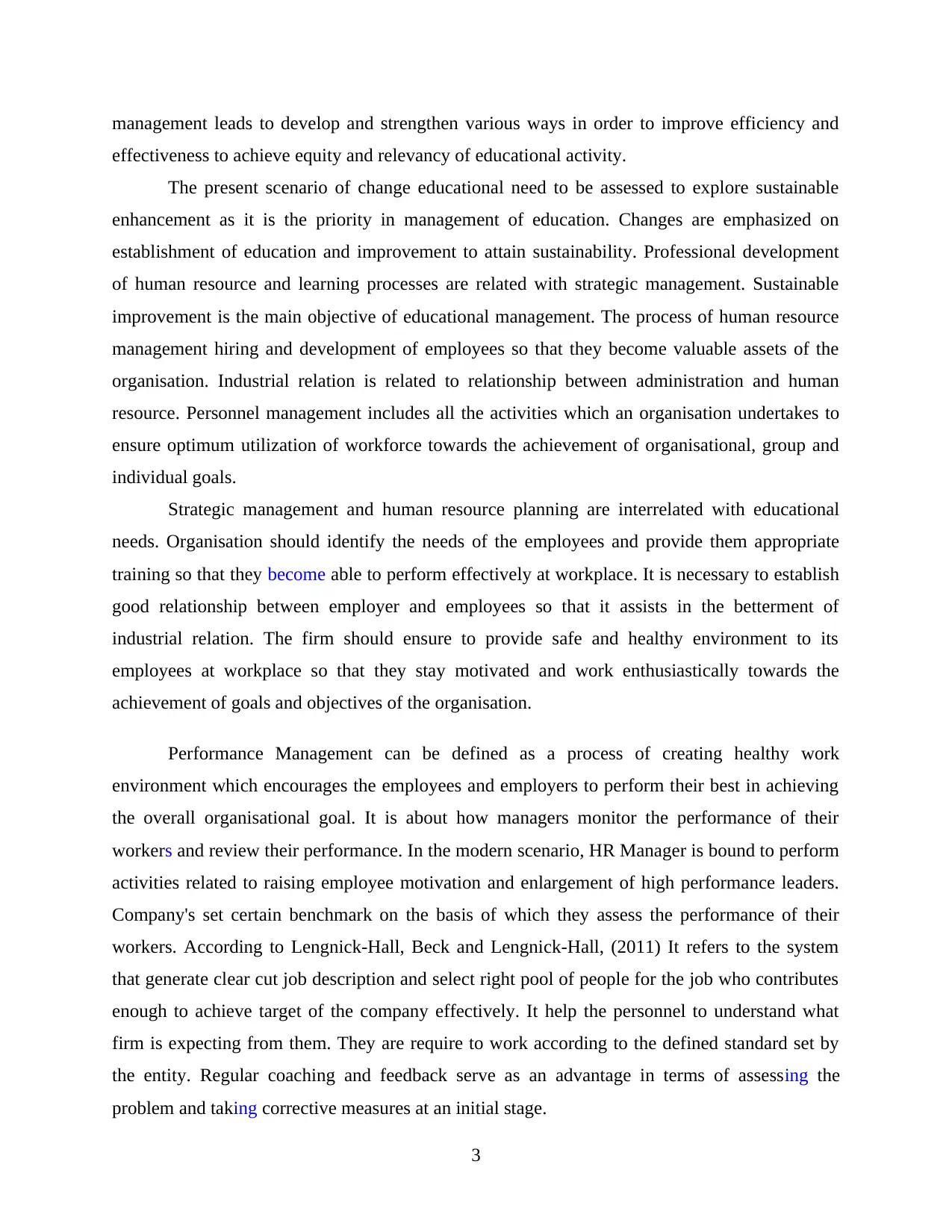
management leads to develop and strengthen various ways in order to improve efficiency and
effectiveness to achieve equity and relevancy of educational activity.
The present scenario of change educational need to be assessed to explore sustainable
enhancement as it is the priority in management of education. Changes are emphasized on
establishment of education and improvement to attain sustainability. Professional development
of human resource and learning processes are related with strategic management. Sustainable
improvement is the main objective of educational management. The process of human resource
management hiring and development of employees so that they become valuable assets of the
organisation. Industrial relation is related to relationship between administration and human
resource. Personnel management includes all the activities which an organisation undertakes to
ensure optimum utilization of workforce towards the achievement of organisational, group and
individual goals.
Strategic management and human resource planning are interrelated with educational
needs. Organisation should identify the needs of the employees and provide them appropriate
training so that they become able to perform effectively at workplace. It is necessary to establish
good relationship between employer and employees so that it assists in the betterment of
industrial relation. The firm should ensure to provide safe and healthy environment to its
employees at workplace so that they stay motivated and work enthusiastically towards the
achievement of goals and objectives of the organisation.
Performance Management can be defined as a process of creating healthy work
environment which encourages the employees and employers to perform their best in achieving
the overall organisational goal. It is about how managers monitor the performance of their
workers and review their performance. In the modern scenario, HR Manager is bound to perform
activities related to raising employee motivation and enlargement of high performance leaders.
Company's set certain benchmark on the basis of which they assess the performance of their
workers. According to Lengnick-Hall, Beck and Lengnick-Hall, (2011) It refers to the system
that generate clear cut job description and select right pool of people for the job who contributes
enough to achieve target of the company effectively. It help the personnel to understand what
firm is expecting from them. They are require to work according to the defined standard set by
the entity. Regular coaching and feedback serve as an advantage in terms of assessing the
problem and taking corrective measures at an initial stage.
3
effectiveness to achieve equity and relevancy of educational activity.
The present scenario of change educational need to be assessed to explore sustainable
enhancement as it is the priority in management of education. Changes are emphasized on
establishment of education and improvement to attain sustainability. Professional development
of human resource and learning processes are related with strategic management. Sustainable
improvement is the main objective of educational management. The process of human resource
management hiring and development of employees so that they become valuable assets of the
organisation. Industrial relation is related to relationship between administration and human
resource. Personnel management includes all the activities which an organisation undertakes to
ensure optimum utilization of workforce towards the achievement of organisational, group and
individual goals.
Strategic management and human resource planning are interrelated with educational
needs. Organisation should identify the needs of the employees and provide them appropriate
training so that they become able to perform effectively at workplace. It is necessary to establish
good relationship between employer and employees so that it assists in the betterment of
industrial relation. The firm should ensure to provide safe and healthy environment to its
employees at workplace so that they stay motivated and work enthusiastically towards the
achievement of goals and objectives of the organisation.
Performance Management can be defined as a process of creating healthy work
environment which encourages the employees and employers to perform their best in achieving
the overall organisational goal. It is about how managers monitor the performance of their
workers and review their performance. In the modern scenario, HR Manager is bound to perform
activities related to raising employee motivation and enlargement of high performance leaders.
Company's set certain benchmark on the basis of which they assess the performance of their
workers. According to Lengnick-Hall, Beck and Lengnick-Hall, (2011) It refers to the system
that generate clear cut job description and select right pool of people for the job who contributes
enough to achieve target of the company effectively. It help the personnel to understand what
firm is expecting from them. They are require to work according to the defined standard set by
the entity. Regular coaching and feedback serve as an advantage in terms of assessing the
problem and taking corrective measures at an initial stage.
3
Paraphrase This Document
Need a fresh take? Get an instant paraphrase of this document with our AI Paraphraser
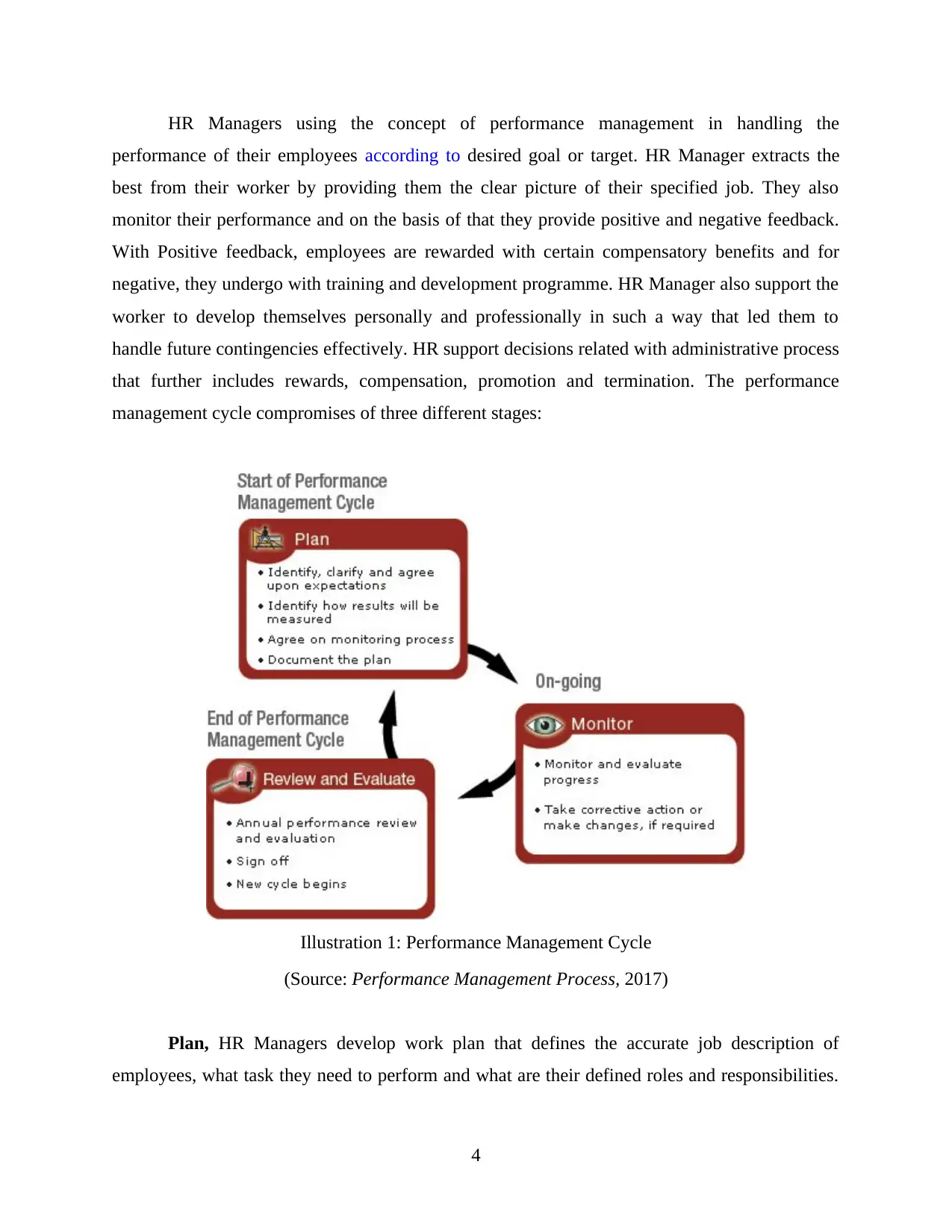
HR Managers using the concept of performance management in handling the
performance of their employees according to desired goal or target. HR Manager extracts the
best from their worker by providing them the clear picture of their specified job. They also
monitor their performance and on the basis of that they provide positive and negative feedback.
With Positive feedback, employees are rewarded with certain compensatory benefits and for
negative, they undergo with training and development programme. HR Manager also support the
worker to develop themselves personally and professionally in such a way that led them to
handle future contingencies effectively. HR support decisions related with administrative process
that further includes rewards, compensation, promotion and termination. The performance
management cycle compromises of three different stages:
(Source: Performance Management Process, 2017)
Plan, HR Managers develop work plan that defines the accurate job description of
employees, what task they need to perform and what are their defined roles and responsibilities.
4
Illustration 1: Performance Management Cycle
performance of their employees according to desired goal or target. HR Manager extracts the
best from their worker by providing them the clear picture of their specified job. They also
monitor their performance and on the basis of that they provide positive and negative feedback.
With Positive feedback, employees are rewarded with certain compensatory benefits and for
negative, they undergo with training and development programme. HR Manager also support the
worker to develop themselves personally and professionally in such a way that led them to
handle future contingencies effectively. HR support decisions related with administrative process
that further includes rewards, compensation, promotion and termination. The performance
management cycle compromises of three different stages:
(Source: Performance Management Process, 2017)
Plan, HR Managers develop work plan that defines the accurate job description of
employees, what task they need to perform and what are their defined roles and responsibilities.
4
Illustration 1: Performance Management Cycle

Certain standards and measures are set according to their specified job description. They set
SMART objectives for their worker according to which they need to perform (Kramar, 2014).
Monitor, At this phase, progress of employees is monitored continuously. They judge on
the basis of their final output or results achieved. Managers identify the barrier which are causing
hindrance in the performance of their personnel. They also share feedback with them, which give
them the opportunity to know their possible weakness or threat.
Review and Evaluate, Managers evaluate the notes and documentation related to their
worker performance management. This can be done by reviewing the final result defined for
each objective. It also includes developing corrective measures which deals with unforeseen
contingencies. They also ensure that each employee should get the copy of this documentation
which may have adverse impact on their personal life as well.
The main focus of Human resource management is related with development of all the
people who are employed at work places so they can enhance their current knowledge level.
Training and development activities should be organised for employees so they can achieve
growth and success and gets an idea how they had to carry out their business operations. If there
are plans developed in order to provide continuous development to all employees then it will
results in achieving all goals and objectives that are set by human resource department.
Employee relations can also be achieved if there is training and other activities organised
for the employees who are involved in performing business activities so they will know how they
had to carry out their working and they can also be educated about different methods which
results in establishing good relations with all the workers so they can achieve the assigned goals
and targets in desired time frames (Daley, 2012).
Health and social care department should also organise workshop training and other
programmes by which they can educate their care workers in relation to the precautions that they
had to adopt while doing treatment of people. There should be development in the machines and
techniques used by them so they can provide treatment to all employees. There should be plans
developed in order to develop continuous education activities for all the workers which results in
developing strong relations.
Human resource management are linked with making strong relations between managers
and employees. This is an important task in order to develop positive working environment
5
SMART objectives for their worker according to which they need to perform (Kramar, 2014).
Monitor, At this phase, progress of employees is monitored continuously. They judge on
the basis of their final output or results achieved. Managers identify the barrier which are causing
hindrance in the performance of their personnel. They also share feedback with them, which give
them the opportunity to know their possible weakness or threat.
Review and Evaluate, Managers evaluate the notes and documentation related to their
worker performance management. This can be done by reviewing the final result defined for
each objective. It also includes developing corrective measures which deals with unforeseen
contingencies. They also ensure that each employee should get the copy of this documentation
which may have adverse impact on their personal life as well.
The main focus of Human resource management is related with development of all the
people who are employed at work places so they can enhance their current knowledge level.
Training and development activities should be organised for employees so they can achieve
growth and success and gets an idea how they had to carry out their business operations. If there
are plans developed in order to provide continuous development to all employees then it will
results in achieving all goals and objectives that are set by human resource department.
Employee relations can also be achieved if there is training and other activities organised
for the employees who are involved in performing business activities so they will know how they
had to carry out their working and they can also be educated about different methods which
results in establishing good relations with all the workers so they can achieve the assigned goals
and targets in desired time frames (Daley, 2012).
Health and social care department should also organise workshop training and other
programmes by which they can educate their care workers in relation to the precautions that they
had to adopt while doing treatment of people. There should be development in the machines and
techniques used by them so they can provide treatment to all employees. There should be plans
developed in order to develop continuous education activities for all the workers which results in
developing strong relations.
Human resource management are linked with making strong relations between managers
and employees. This is an important task in order to develop positive working environment
5
⊘ This is a preview!⊘
Do you want full access?
Subscribe today to unlock all pages.

Trusted by 1+ million students worldwide
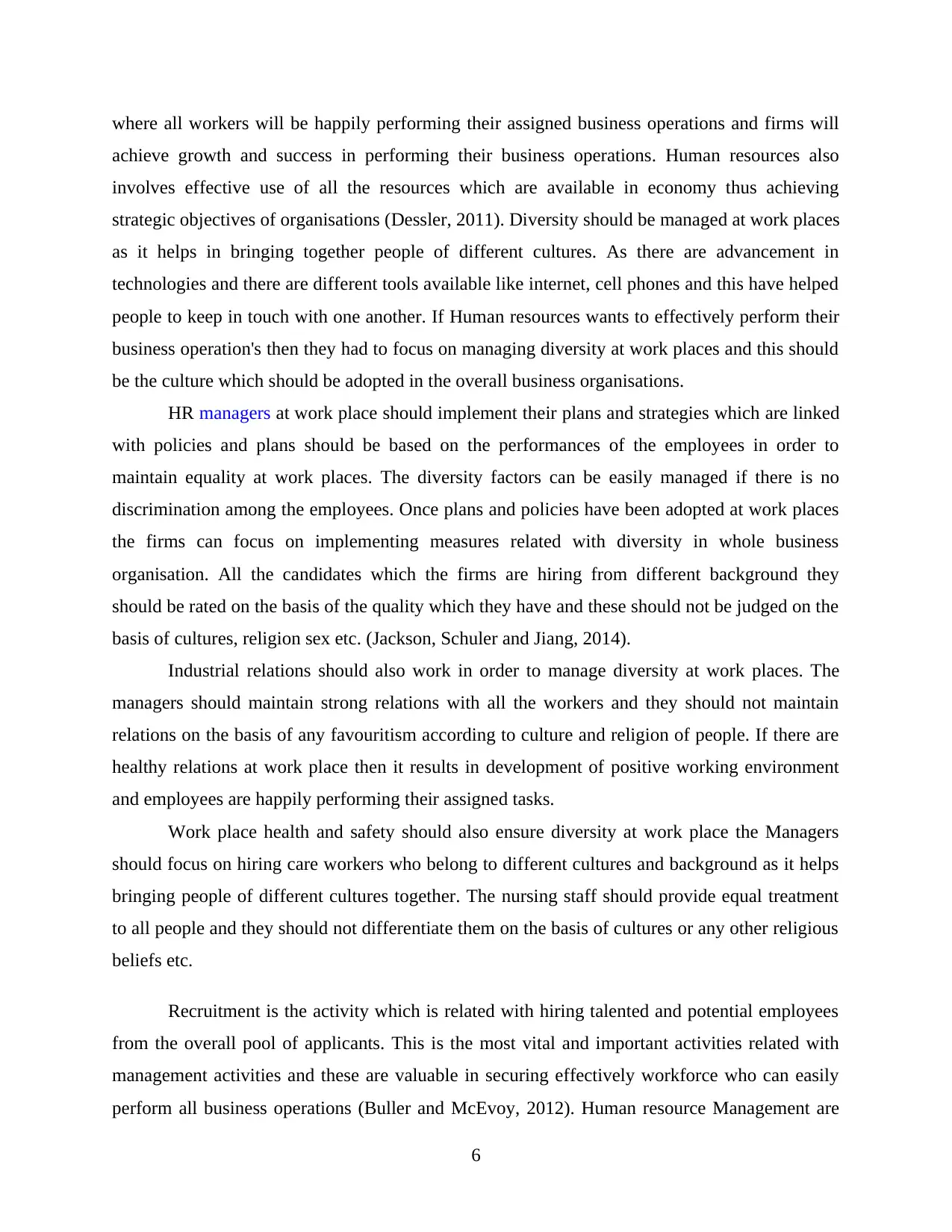
where all workers will be happily performing their assigned business operations and firms will
achieve growth and success in performing their business operations. Human resources also
involves effective use of all the resources which are available in economy thus achieving
strategic objectives of organisations (Dessler, 2011). Diversity should be managed at work places
as it helps in bringing together people of different cultures. As there are advancement in
technologies and there are different tools available like internet, cell phones and this have helped
people to keep in touch with one another. If Human resources wants to effectively perform their
business operation's then they had to focus on managing diversity at work places and this should
be the culture which should be adopted in the overall business organisations.
HR managers at work place should implement their plans and strategies which are linked
with policies and plans should be based on the performances of the employees in order to
maintain equality at work places. The diversity factors can be easily managed if there is no
discrimination among the employees. Once plans and policies have been adopted at work places
the firms can focus on implementing measures related with diversity in whole business
organisation. All the candidates which the firms are hiring from different background they
should be rated on the basis of the quality which they have and these should not be judged on the
basis of cultures, religion sex etc. (Jackson, Schuler and Jiang, 2014).
Industrial relations should also work in order to manage diversity at work places. The
managers should maintain strong relations with all the workers and they should not maintain
relations on the basis of any favouritism according to culture and religion of people. If there are
healthy relations at work place then it results in development of positive working environment
and employees are happily performing their assigned tasks.
Work place health and safety should also ensure diversity at work place the Managers
should focus on hiring care workers who belong to different cultures and background as it helps
bringing people of different cultures together. The nursing staff should provide equal treatment
to all people and they should not differentiate them on the basis of cultures or any other religious
beliefs etc.
Recruitment is the activity which is related with hiring talented and potential employees
from the overall pool of applicants. This is the most vital and important activities related with
management activities and these are valuable in securing effectively workforce who can easily
perform all business operations (Buller and McEvoy, 2012). Human resource Management are
6
achieve growth and success in performing their business operations. Human resources also
involves effective use of all the resources which are available in economy thus achieving
strategic objectives of organisations (Dessler, 2011). Diversity should be managed at work places
as it helps in bringing together people of different cultures. As there are advancement in
technologies and there are different tools available like internet, cell phones and this have helped
people to keep in touch with one another. If Human resources wants to effectively perform their
business operation's then they had to focus on managing diversity at work places and this should
be the culture which should be adopted in the overall business organisations.
HR managers at work place should implement their plans and strategies which are linked
with policies and plans should be based on the performances of the employees in order to
maintain equality at work places. The diversity factors can be easily managed if there is no
discrimination among the employees. Once plans and policies have been adopted at work places
the firms can focus on implementing measures related with diversity in whole business
organisation. All the candidates which the firms are hiring from different background they
should be rated on the basis of the quality which they have and these should not be judged on the
basis of cultures, religion sex etc. (Jackson, Schuler and Jiang, 2014).
Industrial relations should also work in order to manage diversity at work places. The
managers should maintain strong relations with all the workers and they should not maintain
relations on the basis of any favouritism according to culture and religion of people. If there are
healthy relations at work place then it results in development of positive working environment
and employees are happily performing their assigned tasks.
Work place health and safety should also ensure diversity at work place the Managers
should focus on hiring care workers who belong to different cultures and background as it helps
bringing people of different cultures together. The nursing staff should provide equal treatment
to all people and they should not differentiate them on the basis of cultures or any other religious
beliefs etc.
Recruitment is the activity which is related with hiring talented and potential employees
from the overall pool of applicants. This is the most vital and important activities related with
management activities and these are valuable in securing effectively workforce who can easily
perform all business operations (Buller and McEvoy, 2012). Human resource Management are
6
Paraphrase This Document
Need a fresh take? Get an instant paraphrase of this document with our AI Paraphraser

mostly focusing on recruiting skilled and talented employees who can easily perform all business
operations and assist them in achieving growth and success in their business operations. If HRM
are focusing on making plans in order to carry out effective policies for hiring talented workers
who can develop new and innovative ideas by which firms can easily perform all the business
operations. There should also be focus of human resources in order to retain employees for long
time durations so they will easily achieve all business aims and objectives in desired time frames.
The employees can easily be retained if the plans and policies are developed which are beneficial
for them and firms are also working in order to make employees promote at higher levels at work
places.
Good and effective employee relations can be maintained at work places if employees
cooperate with each other. This is an effective policies as employees will not be facing any type
of difficulty in performing their operations thus they will timely achieve all their assigned
targets. The firms can easily achieve success in their business operations if they are focusing on
employee relations and this also results in developing healthy and positive environment at work
places. Employee relations are very beneficial terms as it results in retaining employees for long
time at work places who are having skill and talent and they easily achieve all business goals and
objectives. Retention is helpful in saving cost and time of firms which they would have wasted
on hiring new and potential employees who can make the firms attain growth and success in their
overall business activities (Armstrong, 2011).
The workplace health and safety are also important and vital factors. In order to ensure
better treatment given to all employees, companies should make sound HR policies relating to
health. At health places it is important to develop strong relations among all the care so they can
support each other in order to provide effective treatment to all employees thus organisations can
easily achieve success in performing their business activities. The care workers should be
retained for long time at work place as they are having knowing and experiences how they had to
deal with different patients and provide them effective treatment which is beneficial for them and
cost will also be saved which would have wasted on hiring new workers and provide them
training so they can perform their business activities.
According to the above mentioned report, it can be concluded that in order to achieve
overall organisational goals effectively, company needs to formulate constructive strategy in
their business practices. It refers to the descriptive approach that how plans can be transformed
7
operations and assist them in achieving growth and success in their business operations. If HRM
are focusing on making plans in order to carry out effective policies for hiring talented workers
who can develop new and innovative ideas by which firms can easily perform all the business
operations. There should also be focus of human resources in order to retain employees for long
time durations so they will easily achieve all business aims and objectives in desired time frames.
The employees can easily be retained if the plans and policies are developed which are beneficial
for them and firms are also working in order to make employees promote at higher levels at work
places.
Good and effective employee relations can be maintained at work places if employees
cooperate with each other. This is an effective policies as employees will not be facing any type
of difficulty in performing their operations thus they will timely achieve all their assigned
targets. The firms can easily achieve success in their business operations if they are focusing on
employee relations and this also results in developing healthy and positive environment at work
places. Employee relations are very beneficial terms as it results in retaining employees for long
time at work places who are having skill and talent and they easily achieve all business goals and
objectives. Retention is helpful in saving cost and time of firms which they would have wasted
on hiring new and potential employees who can make the firms attain growth and success in their
overall business activities (Armstrong, 2011).
The workplace health and safety are also important and vital factors. In order to ensure
better treatment given to all employees, companies should make sound HR policies relating to
health. At health places it is important to develop strong relations among all the care so they can
support each other in order to provide effective treatment to all employees thus organisations can
easily achieve success in performing their business activities. The care workers should be
retained for long time at work place as they are having knowing and experiences how they had to
deal with different patients and provide them effective treatment which is beneficial for them and
cost will also be saved which would have wasted on hiring new workers and provide them
training so they can perform their business activities.
According to the above mentioned report, it can be concluded that in order to achieve
overall organisational goals effectively, company needs to formulate constructive strategy in
their business practices. It refers to the descriptive approach that how plans can be transformed
7
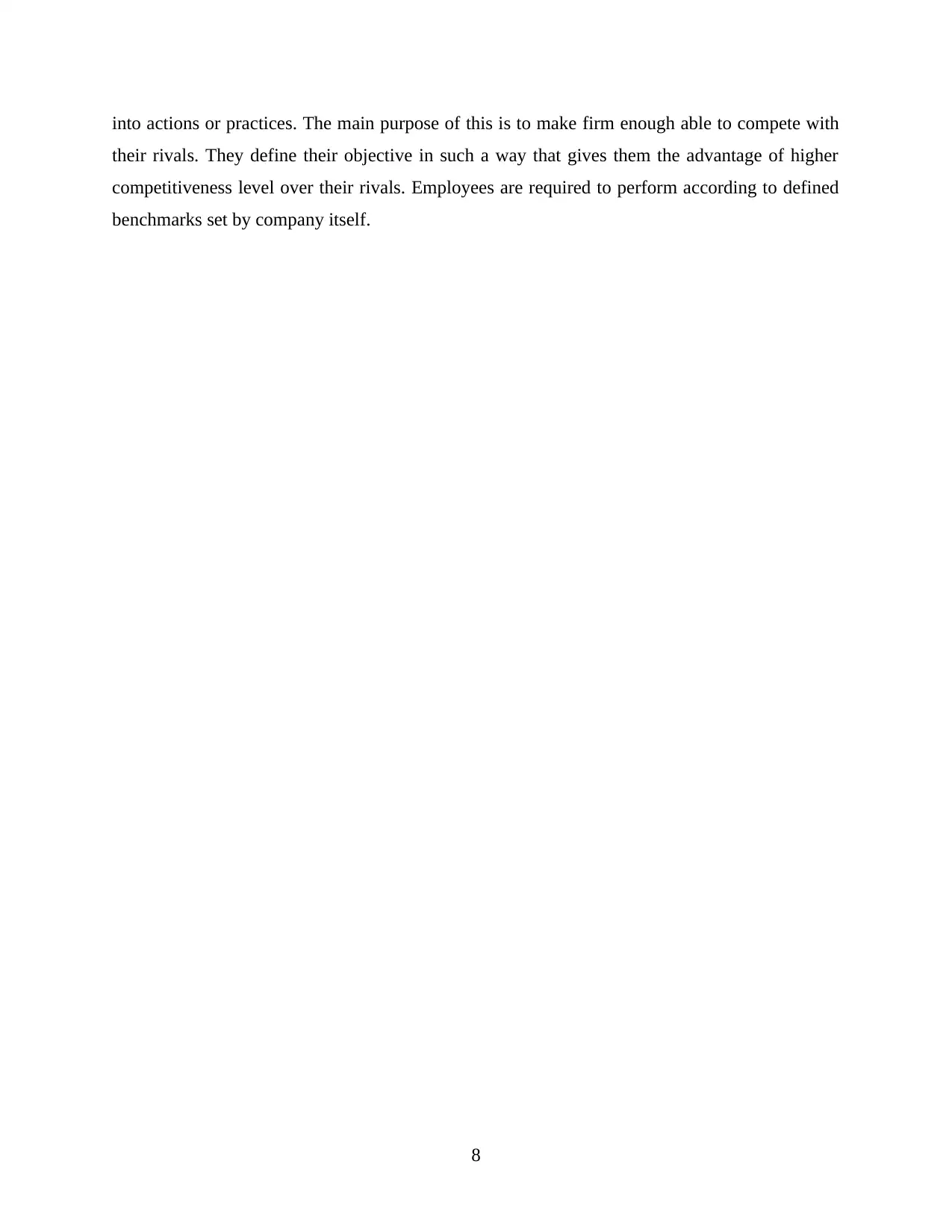
into actions or practices. The main purpose of this is to make firm enough able to compete with
their rivals. They define their objective in such a way that gives them the advantage of higher
competitiveness level over their rivals. Employees are required to perform according to defined
benchmarks set by company itself.
8
their rivals. They define their objective in such a way that gives them the advantage of higher
competitiveness level over their rivals. Employees are required to perform according to defined
benchmarks set by company itself.
8
⊘ This is a preview!⊘
Do you want full access?
Subscribe today to unlock all pages.

Trusted by 1+ million students worldwide

REFERENCES
Books and Journals
Armstrong, M., 2011. Armstrong's handbook of strategic human resource management. Kogan
Page Publishers.
Buller, P. F. and McEvoy, G. M., 2012. Strategy, human resource management and performance:
Sharpening line of sight. Human resource management review. 22(1). pp.43-56.
Daley, D. M., 2012. Strategic human resources management. Public Personnel Management,
pp.120-125.
Dessler, G., 2011. Fundamentals of human resource management. Pearson Higher Ed.
Jackson, S. E., Schuler, R. S. and Jiang, K., 2014. An aspirational framework for strategic human
resource management. Academy of Management Annals. 8(1). pp.1-56.
Kramar, R., 2014. Beyond strategic human resource management: is sustainable human resource
management the next approach?. The International Journal of Human Resource
Management. 25(8). pp.1069-1089.
Lengnick-Hall, C. A., Beck, T. E. and Lengnick-Hall, M. L., 2011. Developing a capacity for
organizational resilience through strategic human resource management. Human
Resource Management Review. 21(3). pp.243-255.
Martín Alcázar, F., Miguel Romero Fernández, P. and Sánchez Gardey, G., 2013. Workforce
diversity in strategic human resource management models: A critical review of the
literature and implications for future research. Cross Cultural Management: An
International Journal. 20(1). pp.39-49.
Storey, J., 2014. New Perspectives on Human Resource Management (Routledge Revivals).
Routledge.
Tooksoon, H. M. P., 2011. Conceptual framework on the relationship between human resource
management practices, job satisfaction, and turnover. Journal of Economics and
Behavioral Studies. 2(2). pp.41-49.
Van Buren, H. J., Greenwood, M. and Sheehan, C., 2011. Strategic human resource management
and the decline of employee focus. Human Resource Management Review. 21(3). pp.209-
219.
Wright, P. M. and McMahan, G. C., 2011. Exploring human capital: putting ‘human’back into
strategic human resource management. Human Resource Management Journal. 21(2).
pp.93-104.
Online
9
Books and Journals
Armstrong, M., 2011. Armstrong's handbook of strategic human resource management. Kogan
Page Publishers.
Buller, P. F. and McEvoy, G. M., 2012. Strategy, human resource management and performance:
Sharpening line of sight. Human resource management review. 22(1). pp.43-56.
Daley, D. M., 2012. Strategic human resources management. Public Personnel Management,
pp.120-125.
Dessler, G., 2011. Fundamentals of human resource management. Pearson Higher Ed.
Jackson, S. E., Schuler, R. S. and Jiang, K., 2014. An aspirational framework for strategic human
resource management. Academy of Management Annals. 8(1). pp.1-56.
Kramar, R., 2014. Beyond strategic human resource management: is sustainable human resource
management the next approach?. The International Journal of Human Resource
Management. 25(8). pp.1069-1089.
Lengnick-Hall, C. A., Beck, T. E. and Lengnick-Hall, M. L., 2011. Developing a capacity for
organizational resilience through strategic human resource management. Human
Resource Management Review. 21(3). pp.243-255.
Martín Alcázar, F., Miguel Romero Fernández, P. and Sánchez Gardey, G., 2013. Workforce
diversity in strategic human resource management models: A critical review of the
literature and implications for future research. Cross Cultural Management: An
International Journal. 20(1). pp.39-49.
Storey, J., 2014. New Perspectives on Human Resource Management (Routledge Revivals).
Routledge.
Tooksoon, H. M. P., 2011. Conceptual framework on the relationship between human resource
management practices, job satisfaction, and turnover. Journal of Economics and
Behavioral Studies. 2(2). pp.41-49.
Van Buren, H. J., Greenwood, M. and Sheehan, C., 2011. Strategic human resource management
and the decline of employee focus. Human Resource Management Review. 21(3). pp.209-
219.
Wright, P. M. and McMahan, G. C., 2011. Exploring human capital: putting ‘human’back into
strategic human resource management. Human Resource Management Journal. 21(2).
pp.93-104.
Online
9
Paraphrase This Document
Need a fresh take? Get an instant paraphrase of this document with our AI Paraphraser

What is strategic human resource management. 2017. [Online]. Available through:
<https://study.com/academy/lesson/strategic-human-resource-management-definition-
importance.html>.
10
<https://study.com/academy/lesson/strategic-human-resource-management-definition-
importance.html>.
10
1 out of 11
Related Documents
Your All-in-One AI-Powered Toolkit for Academic Success.
+13062052269
info@desklib.com
Available 24*7 on WhatsApp / Email
![[object Object]](/_next/static/media/star-bottom.7253800d.svg)
Unlock your academic potential
Copyright © 2020–2025 A2Z Services. All Rights Reserved. Developed and managed by ZUCOL.




